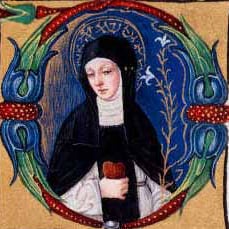Pope Leo XIV – Inaugural Mass Homily
Elected on May 8, 2025, as the 267th successor of St. Peter, Pope Leo XIV’...

Catherine Benincasa was born in the middle of the 14th Century in the Tuscan city of Siena, the daughter of a prosperous middle-class cloth-dyer. From her earliest years at home, amidst all the rigorous chores required to support a large household, she appears to have received visions and lived a life of strict prayer and penance. At age 16, she joined the Third Order of St. Dominic and gave herself to contemplation, the service of the needy, and the reconciliation of sinners. While she wore garb that looks to us like a nun’s habit and vowed herself to virginity, she technically remained a laywoman throughout her entire life. Despite her love for solitude and contemplation, she was called by the Lord to intervene in the great affairs of the day. She sought to be a peacemaker in a war between Florence and the Papacy, and endeavored to end what is known as “the Babylonian Captivity of the Papacy” when the Papal court resided for 70 years not in Rome but in France. After traveling to Avignon to plead with Pope Gregory XI to return to Rome, she herself returned to her native Siena where people of all classes of society gathered around her because of her great sanctity. She is known for her extraordinary devotion to the Precious Blood of Jesus, her letters (more than 400 of which have been preserved) as well as for her book The Dialogue, which is one of the great spiritual classics of the Latin Middle Ages. Yet these important writings were all dictated to various secretaries who belonged to the community of disciples that gathered around her; Catherine only learned to read in her early adulthood and never learned to write proficiently. The last months of her brief life were spent in Rome, at the request of Pope Urban VI who valued her counsel amidst the tragedy of the Great Western Schism. Catherine offered herself as a victim in atonement for the scandal of two rival claimants to the papal throne and died shortly thereafter in Rome in 1380, at the age of 33. There her body remains today, buried under the high altar of the Dominican Church of Santa Maria Sopra Minerva, while her head is venerated in Siena, at the Church of St. Dominic. Catherine was canonized in 1461 and proclaimed a Doctor of the Church in 1970 by Pope Paul VI. She later was named co-patron of Italy with St. Francis of Assisi and co-patron of Europe by St. John Paul II. Biography by Dr. Italy